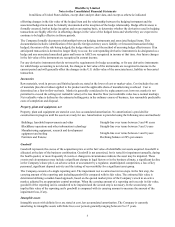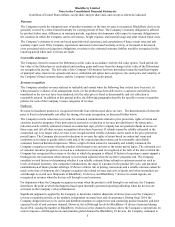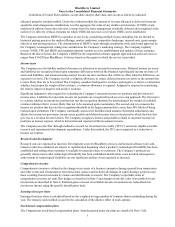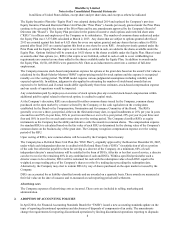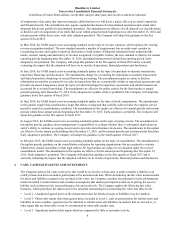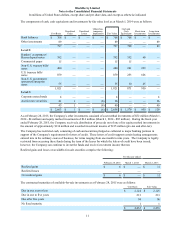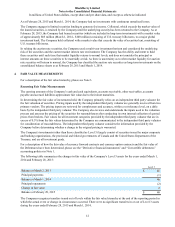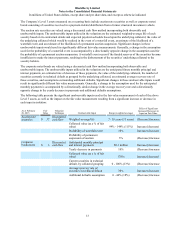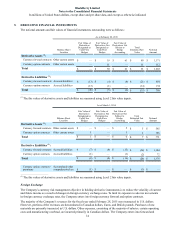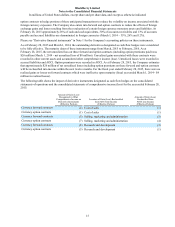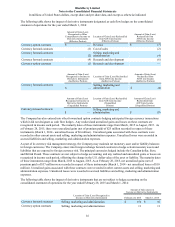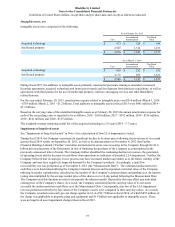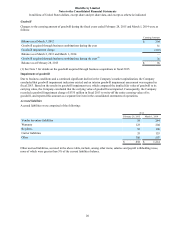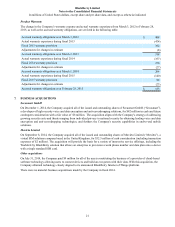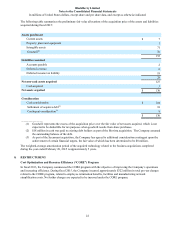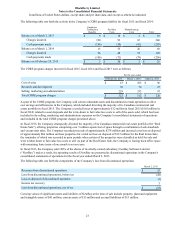Blackberry 2015 Annual Report Download - page 88
Download and view the complete annual report
Please find page 88 of the 2015 Blackberry annual report below. You can navigate through the pages in the report by either clicking on the pages listed below, or by using the keyword search tool below to find specific information within the annual report.
BlackBerry Limited
Notes to the Consolidated Financial Statements
In millions of United States dollars, except share and per share data, and except as otherwise indicated
13
The Company’s Level 3 assets measured on a recurring basis include auction rate securities as well as corporate notes/
bonds consisting of securities received in a payment-in-kind distribution from a former structured investment vehicle.
The auction rate securities are valued using a discounted cash flow method incorporating both observable and
unobservable inputs. The unobservable inputs utilized in the valuation are the estimated weighted-average life of each
security based on its contractual details and expected paydown schedule based upon the underlying collateral, the value of
the underlying collateral which would be realized in the event of a waterfall event, an estimate of the likelihood of a
waterfall event, and an estimate of the likelihood of a permanent auction suspension. Significant changes in these
unobservable inputs would result in significantly different fair value measurements. Generally, a change in the assumption
used for the probability of a waterfall event is accompanied by a directionally opposite change in the assumption used for
the probability of a permanent auction suspension. A waterfall event occurs if the funded reserves of the securities become
insufficient to make the interest payments, resulting in the disbursement of the securities’ underlying collateral to the
security holders.
The corporate notes/bonds are valued using a discounted cash flow method incorporating both observable and
unobservable inputs. The unobservable inputs utilized in the valuation are the anticipated future monthly principal and
interest payments, an estimated rate of decrease of those payments, the value of the underlying collateral, the number of
securities currently in technical default as grouped by the underlying collateral, an estimated average recovery rate of
those securities, and assumptions surrounding additional defaults. Significant changes in these unobservable inputs would
result in significantly different fair value measurements. Generally, a change in the assumption used for the anticipated
monthly payments is accompanied by a directionally similar change in the average recovery rate and a directionally
opposite change in the yearly decrease in payments and additional defaults assumptions.
The following table presents the significant unobservable inputs used in the fair value measurement of each of the above
Level 3 assets, as well as the impact on the fair value measurement resulting from a significant increase or decrease in
each input in isolation:
As at February
28, 2015 Fair
Value Valuation
Technique Unobservable Input Range (weighted average)
Effect of Significant
Increase/(Decrease) in
Input on Fair Value
Auction rate
securities $ 37 Discounted
cash flow Weighted-average life 7 - 18 years (13 years) (Decrease)/increase
Collateral value (as a % of fair
value) 99% - 144% (115%) Increase/(decrease)
Probability of waterfall event 10% Increase/(decrease)
Probability of permanent
suspension of auction 5% (Decrease)/increase
Corporate
bonds/notes $ 3 Discounted
cash flow Anticipated monthly principal
and interest payments $0.1 million Increase/(decrease)
Yearly decrease in payments 10% (Decrease)/increase
Collateral value (as a % of fair
value) 138% Increase/(decrease)
Current securities in technical
default, by collateral grouping 0 - 100% (13%) (Decrease)/increase
Average recovery rate of
securities in technical default 30% Increase/(decrease)
Additional defaults assumption 0 - 44% (18%) (Decrease)/increase


